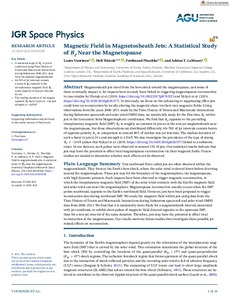Magnetic Field in Magnetosheath Jets: A Statistical Study of BZ Near the Magnetopause
Vuorinen Laura; Hietala Heli; Plaschke Ferdinand; LaMoury Adrian T.
https://urn.fi/URN:NBN:fi-fe2021093048644
Tiivistelmä
Magnetosheath jets travel from the bow shock toward the magnetopause, and some of them eventually impact it. Jet impacts have recently been linked to triggering magnetopause reconnection in case studies by Hietala et al. (2018, https://doi.org/10.1002/2017gl076525) and Nykyri et al. (2019, https://doi.org/10.1029/2018ja026357). In this study, we focus on the enhancing or suppressing effect jets could have on reconnection by locally altering the magnetic shear via their own magnetic fields. Using observations from the years 2008–2011 made by the Time History of Events and Macroscale Interactions during Substorms spacecraft and solar wind OMNI data, we statistically study for the first time  within jets in the Geocentric Solar Magnetospheric coordinates. We find that
within jets in the Geocentric Solar Magnetospheric coordinates. We find that  opposite to the prevailing interplanetary magnetic field (IMF)
opposite to the prevailing interplanetary magnetic field (IMF)  is roughly as common in jets as in the non-jet magnetosheath near the magnetopause, but these observations are distributed differently. 60–70% of jet intervals contain bursts of opposite polarity
is roughly as common in jets as in the non-jet magnetosheath near the magnetopause, but these observations are distributed differently. 60–70% of jet intervals contain bursts of opposite polarity  in comparison to around 40
in comparison to around 40 of similar non-jet intervals. The median duration of such a burst in jets is 10 s and strength is
of similar non-jet intervals. The median duration of such a burst in jets is 10 s and strength is  nT. We also investigate the prevalence of the type of strong
nT. We also investigate the prevalence of the type of strong  nT pulses that Nykyri et al. (2019, https://doi.org/10.1029/2018ja026357) linked to a substorm onset. In our data set, such pulses were observed in around 13% of jets. Our statistical results indicate that jets may have the potential to affect local magnetopause reconnection via their magnetic fields. Future studies are needed to determine whether such effects can be observed.
nT pulses that Nykyri et al. (2019, https://doi.org/10.1029/2018ja026357) linked to a substorm onset. In our data set, such pulses were observed in around 13% of jets. Our statistical results indicate that jets may have the potential to affect local magnetopause reconnection via their magnetic fields. Future studies are needed to determine whether such effects can be observed.
Kokoelmat
- Rinnakkaistallenteet [27094]
